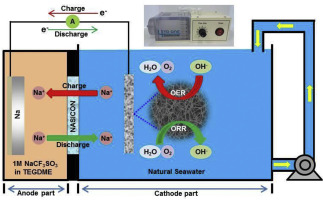A novel rechargeable hybrid Na-seawater flow battery using bifunctional electrocatalytic carbon sponge as cathode current collector
- Journal
- Journal of Power Source
- Vol
- 400
- Page
- 478-484
- Year
- 2018
A novel rechargeable hybrid Na-seawater flow battery, using natural seawater as an abundant source of active materials, have been developed recently. In this kind of metal-air battery, electrochemical oxygen evolution and reduction are the two key processes taking place during charging and discharging, respectively. In general, powder form of electrocatalysts are attached to the current collectors by using inactive and insulating polymer binders, which inevitably impede the overall performance, and increase the manufacturing costs of the battery. Therefore, a simple way to construct the 3D current collector combined with efficient electrocatalytic activities remains a big challenge. In this work, a 3D macroporous carbon sponge is prepared by the direct carbonization of commercially available polymer “Magic Eraser”. The obtained carbon sponge has interconnected macroporous open 3D scaffold structure and exhibits good flexibility and tailorability. The 3D macroporous carbon sponge shows good bifunctional electrocatalytic activities toward oxygen evolution and reduction reactions in seawater. The fabricated hybrid Na-seawater flow battery using 3D macroporous carbon sponge as cathode current collector displays small charge-discharge voltage gap with high voltage efficiency, excellent rechargeability, and long-term cycling stability.

